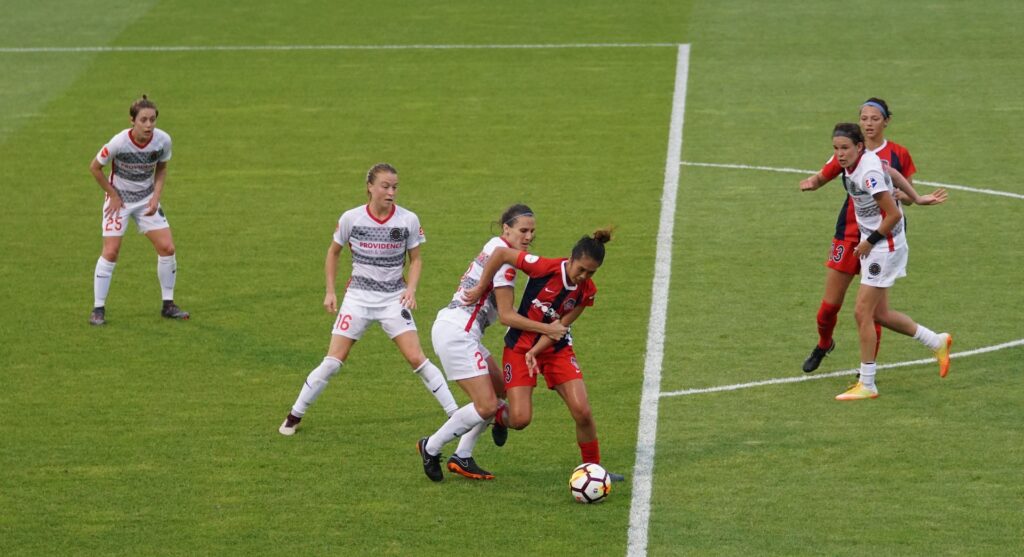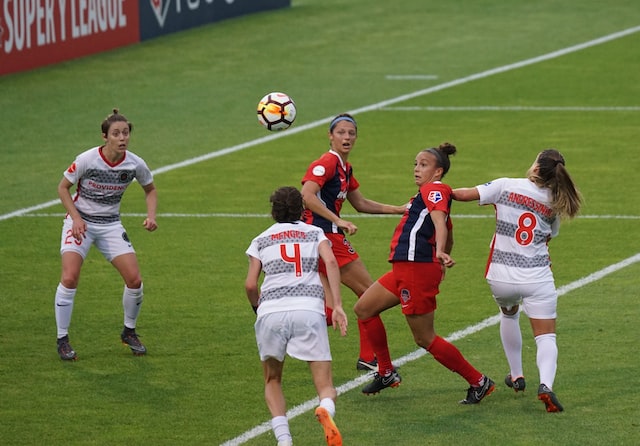Have you ever switched on the game and heard the commentator describe how a team defending from a set-piece is using zonal marking? What does it mean? How does it work?
Well, we’re here to help you understand the system that many managers swear by.
So, what is zonal marking in soccer?
Zonal marking is when, typically from set plays, defenders are assigned defensive responsibility for specific areas of the field and, therefore, any player who enters that area.
If you’re new to soccer, marking means staying close to an attacking player in an attempt to prevent them from having a goalscoring chance or threatening in some other way.
When undertaking zonal marking, defenders will have an area of the pitch to defend. This could be a section of the box or a broader area of the defensive half of the pitch.
Whichever way the manager decides to dissect the defensive zones, the job of handling an attacking player can shift if that attacking player moves from one defensive zone to another.
Where does the concept of zonal marking come from?
Soccer systems weren’t as advanced and meticulous back in the 1950s, so when Fluminense FC implemented zonal marking, people were taken aback.
The plan was of sound reasoning: rather than field three defenders who would man-mark, as was the custom back then, Zezé Moreira opted for a back four that would defend zonally instead to prevent gaps from appearing which could be breached by attackers.
This brand of soccer brought regional and intercontinental success to the Brazilian club, which secured the Campeonato Carioca and the Copa Rio under Moreira’s managerial reign.
Legendary AC Milan manager Arrigo Sacchi built on this philosophy and is considered one of the reasons we see so many modern teams use the zonal marking system today.
In training, Sacchi would ask his players to compete in a game, but there would be no ball; instead, he would shout where the imaginary ball was on the pitch.
This might appear a mad idea at first, but Sacchi’s logic was that his defenders wouldn’t be dragged out of position if there was no ball to be magnetized to. It reinforced his team’s shape and increased the positional sense of his players.
Examples of zonal marking in soccer
Rafael Benítez is a famous example of a manager who much preferred the zonal marking system over man-marking. As the man said himself, Liverpool defended remarkably well in his spell there when he employed zonal marking, and the statistics backed him up.
English clubs at the time were fairly reluctant to employ zonal marking as it was seen as riskier than man-marking, although much has changed these days.
The system clearly became part of the DNA in Liverpool as Jurgen Klopp continued to operate with zonal marking, and to great effect.
The aforementioned Arrigo Sacchi speaks glowingly of the Red’s use of the system. High praise indeed. Ex-Liverpool midfielder Lucas Leiva offers a useful insight into how Klopp’s sides effectively shape up in a 5-3-2 formation within their own box when defending corners.
Each part of the de facto formation is a defensive ‘zone’ which dictates where in the box players should be and their role for defending.
Similarly to their English challengers, Manchester City defends zonally too. Crucially, Pep Guardiola’s side swamps the six-yard box with bodies. This protects the goal, the goalkeeper, and a dangerous zone as well.
Interestingly, Manchester City don’t assemble their players in a straight line because you can cover different angles of attack if the defenders are staggered in zig-zags, and there is less room for attackers to operate in.
Is zonal marking effective?

When done right, zonal marking can be a very effective and successful way of defending.
Often you will see elite-level teams operate zonal marking in defensive units of around four or five players each. From corners, for example, these units could be positioned in lines: one across the six-yard box line and the other around 12 yards out, perhaps.
This is done because whether a corner is deep or short, an in-swinger or an out-swinger, you have defenders spread out across the danger zones in the box evenly so that there will be somebody there to handle the threat in any given space.
These days, many clubs all over the globe conduct their marking zonally and do so with great effect.
Zonal marking vs. man marking
A disadvantage to the man-marking system is that if you’re man-marking a fast and agile striker, their sharp and incisive movements could drag you all over the place, requiring you to hurriedly chase them from one side of the box to the other.
It’s for this reason that zonal marking is far less likely to drag defenders out of position than man-marking, thus avoiding creating gaping holes in the defense. Defenders would remain in their zones so another defender would become the active marker for the attacker’s new position.
Former Liverpool defender Alan Hansen believes that zonal marking actually shares the responsibility for marking between all defensive players rather than the individual responsibility when man-marking.
If a defender loses their player in a zonal marking system, it’s likely that another defender will pick them up instead because attacking players generally shake off their markers through movement.
Critics of zonal marking feel that it can cause defenders to become somewhat static. There’s merit to this argument because when you’re moving around the box to track the attacker’s runs as a man-marker, you create momentum, which can help you leap up for that aerial challenge or slide into a tackle to prevent any danger on the ground.
You don’t want to be stuck in the metaphorical mud should a striker decide to make a diagonal run across the box into your zone to get on the end of a cross.
Zonal marking makes it easier for defenses to set offside traps. Defenders within zonal marking systems are usually synchronized, and their movements are practiced. These lines and positional awareness that defenses form allows all of them to step forward as a unit and catch their attacking opponents offside.
Conversely, if every defender is man-marking instead, it would be incredibly difficult to maintain that defensive synchronization needed to catch attackers in offside positions because they’d just be shadowing the movements of strikers who’d surely drag them away.
Five tips to get zonal marking right
- Communication – making sure your teammates are in the right position for the right scenarios is crucial, and vice versa.
- Synchronization – when your fellow defenders move out or drop back, it’s important that you do too. This will no doubt be worked on in training.
- Focus – all the work that’s been put in on the training ground would be pointless if you don’t remain focused and wary of the existing threats.
- Disregard old habits – you might naturally wander toward either the ball or the man depending on the situation, but it’s important to trust this zonal system.
- Share responsibility – instead of dismissing the problem once the danger has left your zone, help your teammates with vigilance and cooperation.
Conclusion
Zonal marking has proven to be a great way of shaping defenses to remain structurally sound yet versatile to the dynamic nature of goalscoring threats.
It’ll take a lot of work in training, but now that you know how the system operates, maybe your side can implement and perfect the system, which is commonplace among the greatest teams around.
Keen to learn more about defending in soccer? Check out our articles on parking the bus, man on in soccer, keeping a clean sheet, and the best soccer formations for weak teams, for further insight into the art of defending.

